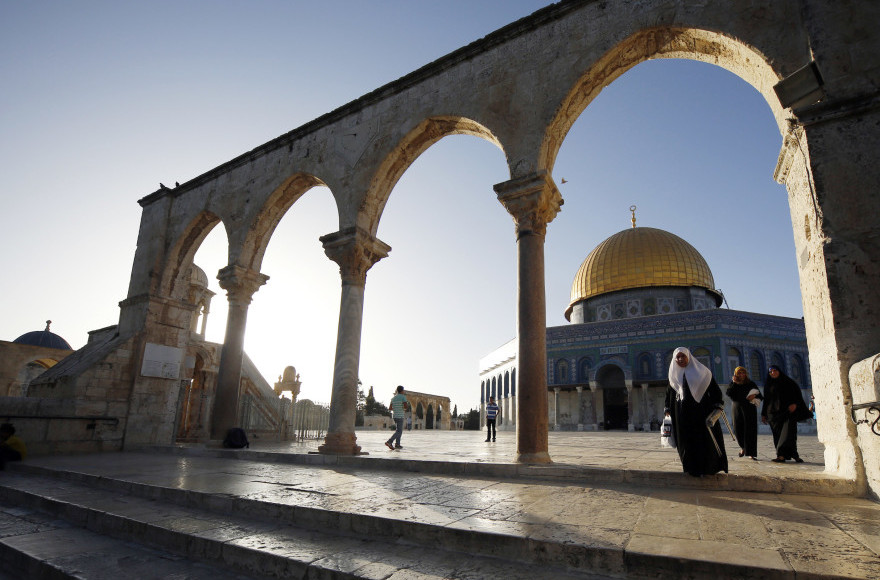
Muslims seen at the Al-Aqsa Mosque, in Jerusalem’s Old City, on their way to pray on the second day of the holy Muslim month of Ramadan, June 30, 2014. (Sliman Khader/Flash90)
Jews call it the Temple Mount, and Muslims the Noble Sanctuary. But this heavily guarded piece of Jerusalem real estate — site of Judaism’s First and Second Temples, two of Islam’s holiest mosques and, according to many, Abraham’s near-sacrifice of his son, Isaac — has a volatile history to say the least.
In recent weeks, violence and tension in eastern Jerusalem has spurred the Israeli government to temporarily close the area or restrict it to people over the age of 50. And on Oct. 29, Rabbi Yehuda Glick – an activist seeking the Jewish right to pray at the Temple Mount – was shot outside a Jerusalem conference center.
It’s hardly the first time the Temple Mount has played center stage in the ongoing saga that is the Israeli-Palestinian conflict. Since the Six-Day War of 1967, when Israel wrested control of the area (as well as the rest of Jerusalem and the West Bank) from Jordan, the Temple Mount has been the setting (and trigger) for numerous violent incidents.
Glick, who is showing signs of improvement (his suspected assailant was later killed), is hardly the first Jew to push for Jewish prayer at the Temple Mount. Attempts began within days after Israel took control of the site, after the government decided to leave management in the hands of the Muslim Wakf while allowing free visitation access to people of all faiths, including Jews.
To avoid provoking Muslims, Israel’s leaders specifically forbade Jews from publicly praying there, a policy that dovetailed nicely with the fact that it was already forbidden by Jewish religious law. The religious prohibition, which Israel’s chief rabbinate announced in 1967 and has reaffirmed, is to prevent Jews from inadvertently stepping over the “Holy of Holies,” where the Ark of the Covenant was said to be stored in the First Temple.
In the first few years after 1967, Jewish efforts to pray at the mount — despite being illegal — were generally civil affairs that were broken up by police with little resistance. The tide began to shift in 1976 when eight members of a French Zionist group called Betar were charged with disturbing the public order by praying together at the Temple Mount. In Jerusalem’s Magistrate’s Court, Magistrate Ruth Or acquitted the youth, but her decision, which challenged the 1967 status quo, sparked “stormy protests” in which dozens of Arab students were arrested for throwing stones at police.
The magistrate’s decision would soon be overruled, but Jewish efforts to pray at the mount continued — and continued to enrage Muslims. In 1979, after rumors spread that supporters of Rabbi Meir Kahane (the infamous founder of the ultra-right Jewish Defense League and the now-outlawed Kach party) would attempt to pray on the Temple Mount, some 2,000 Arabs gathered with “staves, rocks and iron bars” and hurled stones at yeshiva students.
The situation spiraled downward. On April 11, 1982, Alan Harry Goodman, a 38-year-old American bachelor and recent Israeli immigrant went on a shooting spree at the Temple Mount, killing two and injuring dozens. In court, Goodman claimed to be the “messiah” and pleaded insanity. He was sentenced to life imprisonment.
In the early morning of Oct. 8, 1990 some 3,000 Palestinians gathered at the site after rumors spread that the Temple Mount Faithful, a group promoting Jewish prayer at the Temple Mount, was planning a major event there. Many began throwing stones, and Israeli police officers responded by firing live ammunition into the crowds, killing at least 17 and wounding over 100 others. The event badly hurt Israel’s international image and did nothing — to say the least — to quell the intifada that was raging.
A decade later, when Likud party leader Ariel Sharon toured the site with a party delegation and a large number of riot police, many Palestinians and left-wing Israelis saw it as a deliberate provocation, the spark that ignited the second intifada.
This past Friday, Israel’s chief Sephardic rabbi urged Jews to steer clear of the Temple Mount in order to prevent bloodshed.
If history is any indicator, it likely won’t be the last time such pleas are made. Or ignored.
JTA has documented Jewish history in real-time for over a century. Keep our journalism strong by joining us in supporting independent, award-winning reporting.







